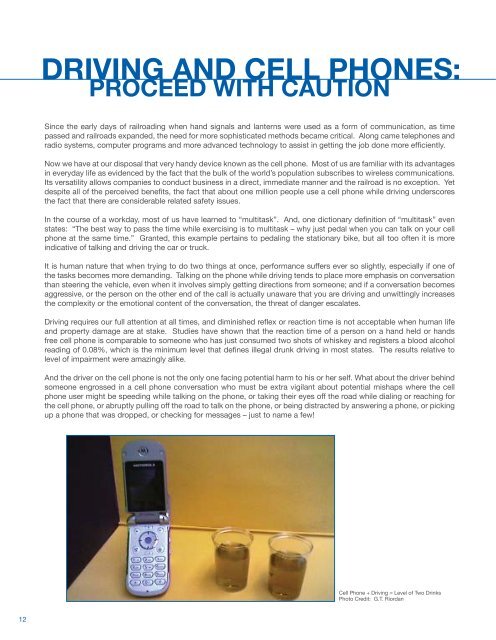THE PAN AM CLIPPER - Pan Am Railways
THE PAN AM CLIPPER - Pan Am Railways
THE PAN AM CLIPPER - Pan Am Railways
You also want an ePaper? Increase the reach of your titles
YUMPU automatically turns print PDFs into web optimized ePapers that Google loves.
12<br />
DRIVING AND CELL PHONES:<br />
PROCEED WITH CAUTION<br />
Since the early days of railroading when hand signals and lanterns were used as a form of communication, as time<br />
passed and railroads expanded, the need for more sophisticated methods became critical. Along came telephones and<br />
radio systems, computer programs and more advanced technology to assist in getting the job done more effi ciently.<br />
Now we have at our disposal that very handy device known as the cell phone. Most of us are familiar with its advantages<br />
in everyday life as evidenced by the fact that the bulk of the world’s population subscribes to wireless communications.<br />
Its versatility allows companies to conduct business in a direct, immediate manner and the railroad is no exception. Yet<br />
despite all of the perceived benefi ts, the fact that about one million people use a cell phone while driving underscores<br />
the fact that there are considerable related safety issues.<br />
In the course of a workday, most of us have learned to “multitask”. And, one dictionary defi nition of “multitask” even<br />
states: “The best way to pass the time while exercising is to multitask – why just pedal when you can talk on your cell<br />
phone at the same time.” Granted, this example pertains to pedaling the stationary bike, but all too often it is more<br />
indicative of talking and driving the car or truck.<br />
It is human nature that when trying to do two things at once, performance suffers ever so slightly, especially if one of<br />
the tasks becomes more demanding. Talking on the phone while driving tends to place more emphasis on conversation<br />
than steering the vehicle, even when it involves simply getting directions from someone; and if a conversation becomes<br />
aggressive, or the person on the other end of the call is actually unaware that you are driving and unwittingly increases<br />
the complexity or the emotional content of the conversation, the threat of danger escalates.<br />
Driving requires our full attention at all times, and diminished refl ex or reaction time is not acceptable when human life<br />
and property damage are at stake. Studies have shown that the reaction time of a person on a hand held or hands<br />
free cell phone is comparable to someone who has just consumed two shots of whiskey and registers a blood alcohol<br />
reading of 0.08%, which is the minimum level that defi nes illegal drunk driving in most states. The results relative to<br />
level of impairment were amazingly alike.<br />
And the driver on the cell phone is not the only one facing potential harm to his or her self. What about the driver behind<br />
someone engrossed in a cell phone conversation who must be extra vigilant about potential mishaps where the cell<br />
phone user might be speeding while talking on the phone, or taking their eyes off the road while dialing or reaching for<br />
the cell phone, or abruptly pulling off the road to talk on the phone, or being distracted by answering a phone, or picking<br />
up a phone that was dropped, or checking for messages – just to name a few!<br />
Cell Phone + Driving = Level of Two Drinks<br />
Photo Credit: G.T. Riordan



